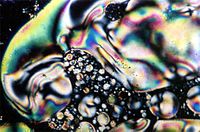
Perspectives in the application of residual dipolar couplings in the structure elucidation of weakly aligned small molecules
Sign Up to like & getrecommendations! Published in 2017 at "Magnetic Resonance in Chemistry"
DOI: 10.1002/mrc.4543
Abstract: This perspective article aims to review the general methodology in the application of residual dipolar couplings (RDCs) in the structure elucidation of small molecules and give the author's view on challenges for future applications. Recent… read more here.
Keywords: residual dipolar; structure elucidation; small molecules; application residual ... See more keywords

Partial alignment, residual dipolar couplings and molecular symmetry in solution NMR.
Sign Up to like & getrecommendations! Published in 2019 at "Journal of biomolecular NMR"
DOI: 10.1007/s10858-019-00256-2
Abstract: Residual dipolar couplings (RDCs) and residual anisotropic chemical shifts (RACSs) are produced by the partial alignment of solution NMR samples. RDCs and RACSs yield high-resolution structural and dynamic information on the orientation of bonds and… read more here.
Keywords: solution nmr; residual dipolar; symmetry; molecular symmetry ... See more keywords

A practical strategy for the accurate measurement of residual dipolar couplings in strongly aligned small molecules.
Sign Up to like & getrecommendations! Published in 2018 at "Journal of magnetic resonance"
DOI: 10.1016/j.jmr.2018.04.002
Abstract: Accurate measurement of residual dipolar couplings (RDCs) requires an appropriate degree of alignment in order to optimize data quality. An overly weak alignment yields very small anisotropic data that are susceptible to measurement errors, whereas… read more here.
Keywords: residual dipolar; alignment; accurate measurement; measurement ... See more keywords

Progressive Stereo Locking (PSL): A Residual Dipolar Coupling Based Force Field Method for Determining the Relative Configuration of Natural Products and Other Small Molecules.
Sign Up to like & getrecommendations! Published in 2017 at "ACS chemical biology"
DOI: 10.1021/acschembio.7b00281
Abstract: Establishing the relative configuration of a bioactive natural product represents the most challenging part in determining its structure. Residual dipolar couplings (RDCs) are sensitive probes of the relative spatial orientation of internuclear vectors. We adapted… read more here.
Keywords: force field; residual dipolar; configuration; relative configuration ... See more keywords

Programmable alignment media from self-assembled oligopeptide amphiphiles for the measurement of independent sets of residual dipolar couplings in organic solvents
Sign Up to like & getrecommendations! Published in 2022 at "Chemical Science"
DOI: 10.1039/d2sc01057g
Abstract: NMR spectroscopy in anisotropic media has emerged as a powerful technique for the structural elucidation of organic molecules. Its application requires weak alignment of analytes by means of suitable alignment media. Although a number of… read more here.
Keywords: alignment media; organic solvents; residual dipolar; sets residual ... See more keywords

Residual dipolar couplings as a tool for structural analysis of ionic liquids.
Sign Up to like & getrecommendations! Published in 2023 at "Chemical communications"
DOI: 10.1039/d3cc00929g
Abstract: An acrylonitrile/dimethylacrylamide cross-linked polymer could be swollen in different imidazolium ionic liquids. Mechanical compression of the obtained polymer gels inside an NMR tube allowed the measurement of residual dipolar couplings. Conformational analysis of the 1-methyl-3-butyl-imidazolium… read more here.
Keywords: tool structural; couplings tool; ionic liquids; analysis ... See more keywords

Weakly aligned Ti3C2Tx MXene liquid crystals: measuring residual dipolar coupling in multiple co-solvent systems.
Sign Up to like & getrecommendations! Published in 2023 at "Nanoscale"
DOI: 10.1039/d3nr00204g
Abstract: Residual Dipolar Coupling (RDC), acquired relying on weakly alignment media, is highly valuable for the structural elucidation of organic molecules. Arising from the striking features of no background signals and low critical concentrations, two-dimensional (2D)… read more here.
Keywords: liquid crystals; dipolar coupling; ti3c2tx mxene; residual dipolar ... See more keywords

Residual Dipolar Couplings for Resolving Cysteine Bridges in Disulfide-Rich Peptides
Sign Up to like & getrecommendations! Published in 2019 at "Frontiers in Chemistry"
DOI: 10.3389/fchem.2019.00889
Abstract: Disulfide bridges in proteins are formed by the oxidation of pairs of cysteine residues. These cross-links play a critical role in stabilizing the 3D-structure of small disulfide rich polypeptides such as hormones and venom toxins.… read more here.
Keywords: resolution; residual dipolar; cysteine; disulfide rich ... See more keywords